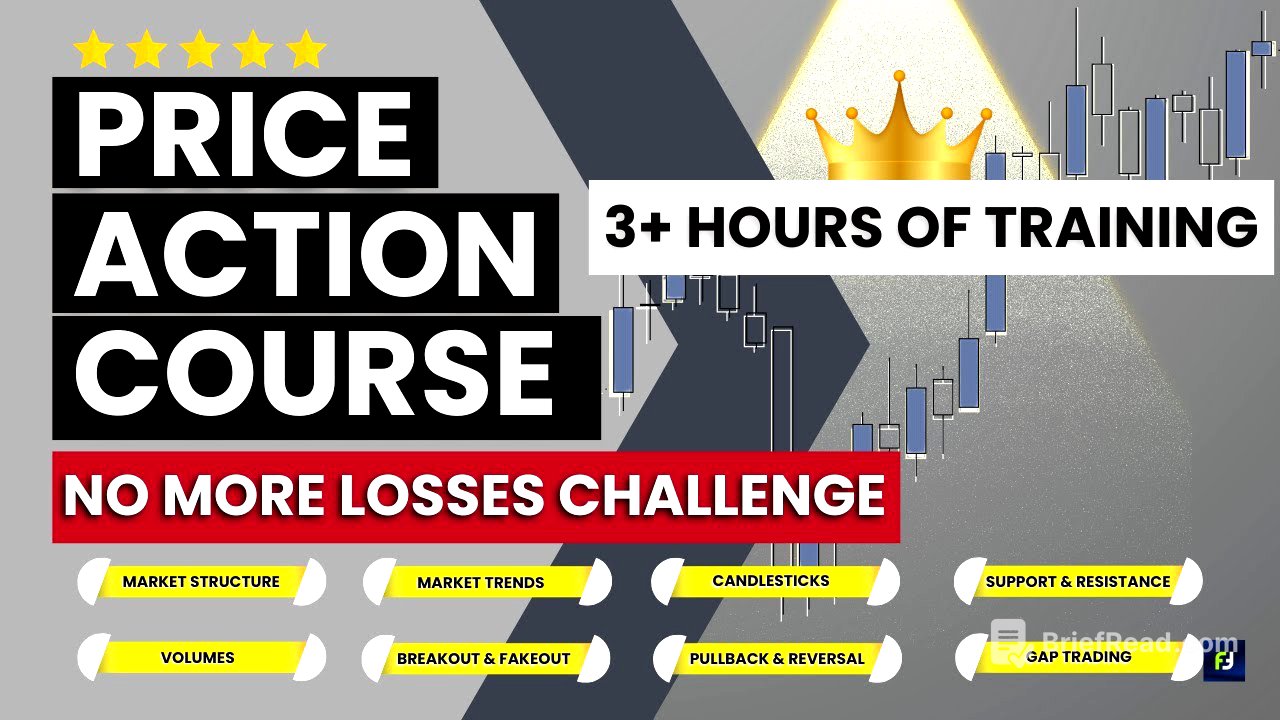TLDR;
This YouTube video transcript provides a comprehensive course on price action trading, covering essential concepts and strategies. It begins with an introduction to price action analysis, emphasizing its focus on price and volume over indicators. The course progresses through understanding market movements, identifying trends, interpreting candlestick patterns, and utilizing support and resistance levels. It also covers advanced strategies such as trading breakouts, reversals, and gaps, providing practical tips and techniques for successful implementation.
- Price action trading focuses on price and volume, offering a direct view of market activity.
- Understanding market trends and candlestick patterns is crucial for making informed trading decisions.
- Support and resistance levels help identify potential buying and selling opportunities.
- Breakout, reversal, and gap trading strategies can be used to profit from different market conditions.
Episode 1 [0:29]
The stock market revolves around buying and selling, driven by demand and supply. Profitable trading requires an edge, obtainable through technical, fundamental, quantitative, or price action analysis. Technical analysis uses indicators derived from price and volume, while fundamental analysis focuses on a company's financials. Quantitative analysis employs statistical tools. Price action, unlike other methods, directly reflects market activity by studying price behavior, recent prices, market trends, and price structure. While not a guaranteed success, price action trading, when combined with sound psychology and implementation, can improve trade entries and exits.
Episode 2 [4:42]
Market prices move in specific patterns due to the actions of major players, primarily institutions. While news and government policies can influence prices, company earnings are central to market movements. Institutions, including mutual funds, banks, and hedge funds, account for most trading volume and control market direction. Retail traders' small trades depend on institutions' willingness to participate. To succeed, traders should align with institutional trends, recognizing that market dynamics shift between uptrends, downtrends, and consolidation phases, which include accumulation and distribution. Institutions strategically accumulate positions during the accumulation phase and distribute them during the distribution phase, influencing market trends.
Episode 3 [15:42]
Market trends, ranging from short-term to long-term, reflect the overall direction of the market over a specified period. The three main types of trends are uptrends, downtrends, and sideways trends. Trend lines and indicators like moving averages can identify these trends, but this course focuses on trend lines for cleaner charts. Trends are relative to the time frame used for analysis, with investors, swing traders, and intraday traders potentially having different views on the same market. Understanding price swings, consisting of impulse and corrective moves, is crucial. Uptrends are marked by higher swing highs and lows, while downtrends feature lower swing highs and lows. Identifying swing transitions helps determine when a trend ends and consolidation begins. Sideways trends include range contraction, expansion, and triangular ranges, each with unique characteristics.
Episode 4 [30:36]
Candlestick patterns visually represent market prices, consisting of a real body and shadows (wicks). Each candle has four price points: open, high, low, and close (OHLC). The color of the body indicates bullish (green/white) or bearish (red/black) price movement. Instead of memorizing numerous patterns, focus on understanding the OHLC and market dominance (bulls vs. bears). Marubozu candles, with large real bodies and no wicks, are the strongest bullish or bearish signals. Pin bars, such as hammers and hanging men, indicate potential reversals, with hammers at the bottom of downtrends and hanging men at the top of uptrends. Shooting stars and inverted hammers also signal reversals but are weaker. Spinning tops, with small real bodies and equal shadows, represent indecision. Dojis, similar to spinning tops but without a real body, also convey market indecision.
Episode 5 [46:49]
Support and resistance levels are key price points that attract buying or selling activity. Support levels are where more buyers are expected, preventing further price declines, while resistance levels attract sellers, hindering price increases. These levels are influenced by institutional actions, such as accumulating or distributing shares. Drawing support and resistance involves loading data, zooming out, identifying price action zones, aligning zones, and fitting horizontal lines. Critical levels are indicated by price hesitation or sharp reversals. Instead of single lines, represent these levels as zones to account for approximation risk. Support and resistance are indicative, not definitive, and should be used with other confirmations, such as price action candles, to create a robust trading system.
Episode 6 [57:49]
Identifying when support or resistance will break involves recognizing patterns like higher lows into resistance or lower highs into support, indicating potential breakouts. Trading reversals requires strong momentum into a support or resistance area, followed by price rejection, often signaled by pin bars. This strategy leverages the difference between support and resistance levels for a higher reward-to-risk ratio. Breakout trades, conversely, benefit from ascending or descending triangle patterns, where buyers or sellers are increasingly willing to trade at higher or lower prices. Additionally, a buildup supported by a moving average can signal an impending breakout. To find overlooked opportunities, analyze higher time frames for tight consolidation patterns, which can reveal support and resistance trading opportunities on lower time frames.
Episode 7 [1:13:04]
Market volume is a leading indicator that precedes price movements, reflecting the number of shares bought and sold. High volume indicates strong trading activity, often driven by institutional investors, while low volume suggests less institutional interest. Comparing today's volume to the average of the last 10 days helps gauge market interest. When both price and volume increase, it signals strong institutional buying interest, leading to bullish expectations. Conversely, increasing price with decreasing volume suggests retail-driven activity, warranting caution. Decreasing price with increasing volume indicates institutional selling, setting a bearish expectation. Finally, decreasing price and volume suggest retail selling, which could lead to a bear trap. Delivery volume and percentage provide further insights into institutional interest.
Episode 8 [1:31:19]
Breakout trading involves entering trades when the price moves beyond a level of importance, such as resistance, support, or a trend line. While exciting, it also carries risks like false breakouts. Breakout trades offer limited risk, momentum in your favor, and predefined entry and exit points. However, they can result in false breakouts and infrequent optimal setups. Avoid trading breakouts against the trend or when the price is far from market structure. High-probability breakout trades align with the trend and occur near market structure. Trend trading breakouts involve buying above swing highs in an uptrend or selling below swing lows in a downtrend, using moving averages or trend lines for guidance. Trading breakouts near market structure, such as breakouts with buildup, higher lows into resistance, or lower highs into support, offers tighter stop losses and better risk-reward ratios.
Episode 9 [1:51:47]
False breakouts, or "fake outs," are a common challenge in breakout trading. To minimize their impact, avoid chasing power moves into areas of value, as these often lack support and can lead to reversals. Instead, look for higher lows into resistance or lower highs into support, indicating genuine strength or weakness. Use candlestick and volume analysis to confirm breakouts, seeking higher-than-average volume and waiting for candlesticks to close through support or resistance lines. Additionally, wait for price to retrace back to the level and then move in the breakout direction. RSI convergence can also confirm breakouts by showing increasing momentum.
Episode 10 [2:03:08]
Pullback trading involves buying dips in uptrends or selling rallies in downtrends, offering safer entries with confirmation. While it may lead to missing some moves, it aligns with buying low and selling high. To approach pullback trades, identify the market trend, find an area of value (swing points, support/resistance, trend lines, moving averages), and look for entry triggers like reversal candlestick patterns. Set stop losses below swing lows in uptrends or above swing highs in downtrends, using ATR for buffer. Set targets at swing highs or resistance levels, or trail stop losses to ride the trend. Strategies include breakout pullbacks, horizontal steps, trend lines, and moving averages.
Episode 11 [2:21:51]
Reversal trading aims to profit from large price changes where trends change direction. While potentially profitable, it requires careful execution to avoid common mistakes. Avoid "catching a falling knife" by entering long positions in crashing markets without support. Also, avoid entering the first pullback, which is often just a retracement. Instead, have a reference point (trend, consolidation, area of value), wait for the market to reach it, and look for reversal candlestick patterns for entry. Place stop losses at levels that invalidate the setup and set conservative profit targets. Techniques include identifying breaks in market structure, using higher time frame reversal structures, and using moving averages to determine bias.
Episode 12 [2:37:54]
The inside bar pattern, where a candle's range is completely within the previous candle's range, signals indecision. Different types include small-range, large-range, and multiple inside bars, each with unique implications. The Hikkake pattern, a variation, identifies false breakouts. Inside bars are best traded on higher time frames. Strategies include trading inside bar breakouts, reversals, and trend continuations. Breakout strategies involve entering when price breaks the inside bar's high or low in the direction of the trend, though they can generate false signals. Reversal strategies involve identifying inside bars at swing points or key levels, waiting for confirmation, and setting stop losses using ATR. Trend trading strategies involve using inside bars to catch pullbacks in strong trends, entering when price resumes the trend direction.
Episode 13 [2:54:26]
Gaps, or discontinuities in price charts, occur due to demand-supply imbalances, overnight sentiments, or strategic actions by smart money. Gaps can act as support or resistance levels, and while most gaps eventually fill, it can take a long time. Different types of gaps include breakaway gaps (breaking support/resistance), runaway gaps (continuation of trend), and exhaustion gaps (weak moves). Trading gaps involves considering volume, opening price, and pullbacks. Strategies are based on outside gaps (market opens outside previous day's range) and inside gaps (market opens inside previous day's range). Avoid trading the first hour after market open and focus on high-probability setups.
Episode 14 [3:08:09]
Trading full gaps involves waiting for a pullback to the previous day's high (in a full gap up) or low (in a full gap down), then entering a continuation trade when price breaks above or below the opening range. Avoid trading if the gap is too large, as the probability of a pullback is low. For partial gaps, where the open price is within the previous day's range, the gap acts as support or resistance. Enter a long trade in a partial gap up if the pullback tests the gap with lighter volume and a bullish signal is triggered. Conversely, enter a short trade in a partial gap down if the pullback tests the gap with smaller volume and a bearish signal is triggered. Always trade in the direction of the gap and back test strategies for comfort and success.









